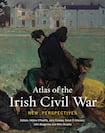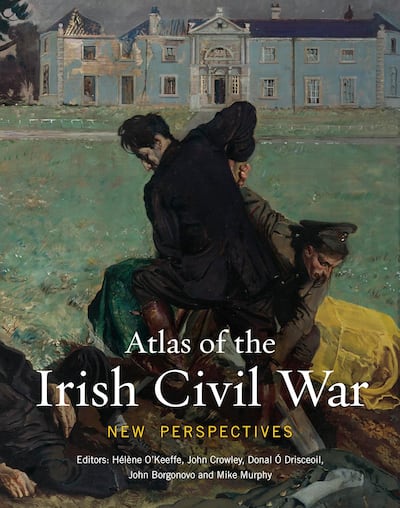
The Atlas of the Irish Civil War is the third in a series of historical atlases produced by editors based in University College Cork, and published by Cork University Press. Many households in Ireland and abroad are adorned by the previous two – the Atlas of the Great Irish Famine 1845-52, published in 2012, and the Atlas of the Irish Revolution, published in 2017. The current volume is edited by Helene O’Keefe, John Crowley, Donal Ó Drisceoil, John Borgonovo and Mike Murphy. This is now a formidable series of books which presents Irish history and geography with imagination, innovation, scholarship and engagement.
President Michael D Higgins is a fan of the series, and has again contributed a thoughtful and well-informed foreword to this volume. It is worth quoting some of his reflections:
“The Civil War was not inevitable. The violence that was waged as part of Ireland’s Civil War in 1922-23, and the bitterness and exclusion of its outcome, were an appalling tragedy for so many Irish families ... its aftermath constituted a bitter remnant that stained Irish society, casting dark shadows of real and imagined versions of military successes and losses that in their narrowness, prevented social egalitarianism and impeded cohesion.”
He further mentions “the strident tones of a nationalism that would ape so much of empire’s assumptions. While it displaced the formal version of the previous colonial authority, it mimicked it with a new but similar version that bore ... more localised authoritarian tendencies, ones with strong clericalist leanings.”
These are important words, which reflect on the narrowness of militaristic nationalism, its similarity to imperial repression, and its undoubted authoritarian tendencies. The issues raised in this volume are at the core of concerns still with us today: democratic legitimacy; authoritarian tendencies; propaganda; divided and bitter discourse; gender; class; the land issue; ordinary crime; sexual violence; death, injury, bereavement and trauma; poverty; and global connections and relationships.
The book has a coherent, concise, clear introduction, laying out the trajectory of the Civil War. There are 13 core chapters: British perspectives on the Civil War; the war in the provinces; political violence in Northern Ireland; labour, land and everyday life; propaganda and legitimisation; the dead; gender, poverty and religion; imprisonment; global connections; legacies; Civil War poetry; historiography of the Civil War; and historians and the “silence” of the war. There are individual studies on Dorothy Macardle, Arthur Griffith, Liam Lynch and Sean O’Casey. There are 20 case studies, numerous caption essays, 40 maps, 400 photographs and a multitude of archival documents.
It is worth looking at one section in detail to illustrate how the Atlas structures its wealth of material to maximum effect. There is a piece, six pages long, by Prof Terry Dooley, on the 1923 Land Act. He gives us a compact but comprehensive description of a hugely important piece of legislation, with details of agrarian activities from 1917 to 1923 – “micro social revolutions took place across the country” – with the burning of certain big houses ensuring the distribution of untenanted land.
He describes one of the most interesting aspects of the Act: “It culminated in the transfer of all tenanted lands from landlord to tenant ... and the almost complete acquisition of demesne and untenanted lands for redistribution in order to tackle congestion. It therefore initiated a social engineering project of historic magnitude ... including the migration of thousands of families from congested areas in the west to new farms in the east and midlands.” He also tells us that landless labourers were the last to benefit from this new regime, a factor that helped Fianna Fáil into office 10 years later.
As adjuncts to this piece of text, there is a concise biography of Patrick Hogan, the minister for agriculture responsible for the Act, a short piece on the burning of Moydrum Castle in Co Westmeath, with an image of the building in all its pre-incendiary glory, a photo of the long-awaited Land Commission records in their boxes in Portlaoise, a map of land sales in Co Monaghan, 1881-1903, and a Fianna Fáil cartoon poster from 1933, displaying the British cabinet discussing Cumann na nGaedhal’s usefully craven attitude toward the payment of Land Annuities, and urging the electorate to give Fianna Fáil a clear majority, which indeed they did.

The methodology used here is replicated throughout the book: a spine of expert text, augmented by maps, photographs and documents, all of which are captioned comprehensively. Of course we could go to the Dictionary of Irish Biography for Paddy Hogan’s biography, but how much more useful it is to get it here, under a photo of him at his desk looking about 15 years old. And that is a reminder of how young most of the participants in these tumultuous events were. Of course we could also go to Terry Dooley’s own groundbreaking book, Burning the Big House, for the sad but intricate story of the demise of the crenellated Moydrum Castle at the hands of people with a lot to gain from this action, but how much better it is to have it right here before us with a picture of the castle in its heyday.
And so on. The great value of this Atlas and its predecessors is the innovative and meticulous use of visual imagery – maps, photographs, archival documents, cartoons, proclamations, and much more – and their careful explication, to help us see things in a new and complicated way. These beguiling captions are almost a parallel text, aided by the magnetic lure of pictures, which automatically draw the eye. It is possible to spend a few profitable hours just leafing through this book, as it sits securely on a sturdy table (it is very heavy), looking at pictures and their captions, and to come away very well informed, but of course it is better to read each full section as it comes, and be even better informed.
One of the most important developments in scholarship and public engagement over the Decade of Centenaries has been a new focus on death, bereavement and trauma resulting from the different conflicts which occurred. The Atlas devotes serious space and reflection to this issue, with a core chapter on the Dead, which reveals more exact figures for Civil War deaths than we have ever had before: 648 National Army, 458 anti-Treaty, 335 civilians and four members of Crown forces. This gives us a total of 1,425, increasing to 1,484 if the North is included. The charts and maps in this chapter do what such things do best – they enhance our understanding of the underlying nature and causes of these events.
Thus, we get comprehensive and easily digestible information on the geographical and temporal distribution of deaths from the end of June 1922 to the end of May 1923; of the density of killing by county; of breakdown by age, gender, social class and occupation; and we get a remarkable chart on causes of death: 30.8 per cent of National Army deaths and 20.6 per cent of civilian deaths were caused by accidents; only 10.3 per cent of anti-Treaty IRA deaths were. But 22.5 per cent of anti-Treaty IRA deaths took place in custody, and 18.5 per cent were executions.
From this we get a picture of ill-trained National Army recruits with access to plenty of weapons dying as a result of ignorance or carelessness with regard to those weapons and explosives, and motor accidents, still a significant cause of death today. We also see that the state exercised its power in sinister ways when it came to fatal treatment of prisoners, and of course the infamous executions policy, ably dissected in this section by Sean Enright.
All of this data is examined by the authors, Andy Bielenberg, John Dorney and Helene O’Keefe, to give us a rich picture of who the dead of the Civil War were. The chapter is personalised with memorial cards, photos and a last letter from Jim Lillis of Bagenalstown, Co Carlow, about to be executed next morning, sending his brother, John, his safety razor, a lock of his hair and his love and prayers. We also get the story of Private Christopher Kearns, ambushed by the anti-Treaty IRA at Ferrycarrig bridge, Co Wexford, and killed with three of his comrades. His mother sought his personal effects, but the Army described his uniform as being “in such a state of blood and dirt” that it could not be handed over.
The dead of the Civil War are listed at the end of the book, as a distinct commemorative act, with the sources consulted to gather this information also listed. Eunan O’Halpin and Daithi O’Corrain gave us the dead of 1916 and the War of Independence; this sad list completes the task of enumerating those who perished during our turbulent so-called revolutionary period. Lost lives, enumerated without hierarchical distinctions between combatants and civilians, remind us of the irreparable losses caused by armed conflict.
Let us not be subject to the tyranny of anniversaries; all too often, we have intense interest in a particular period – 1798, the Great Famine – followed by amnesia as we move on to the next anniversary for which funding is made available. There are many references in this impressive book to the necessity for further research; let’s not stop looking at this crucial period because more than 100 years have passed.
Catriona Crowe is former Head of Special Projects at the National Archives of Ireland
Further reading
Between Two Hells: The Irish Civil War by Diarmaid Ferriter (2021): A thorough exploration of the Civil War and its aftermath, using the newly available Military Service Pensions files to maximum effect, and demonstrating the archival dexterity of the author. An indispensable guide to the causes and effects of an awful conflict.
The Irish Civil War and Society: Politics, Class and Conflict by Gavin Foster (2015): An examination of class as an aspect and driver of the Civil War, with fascinating material on how it affected mutual perceptions of the opposing groups. Foster interrogates “respectability” as a concept and cause for various groups, not always those we might expect.
militaryarchives.ie: The website for the most voluminous collection of material relating to the various nationalist conflicts, including the Civil War. Beautifully catalogued, with files digitised, searchable and available free online. A multitude of human stories that bring the reader into the heart of conflict and its effects.














